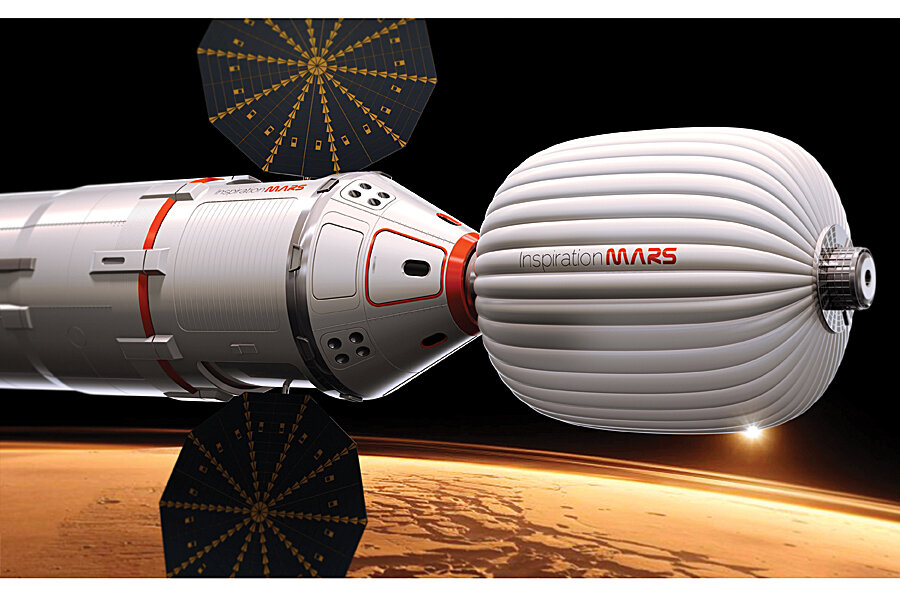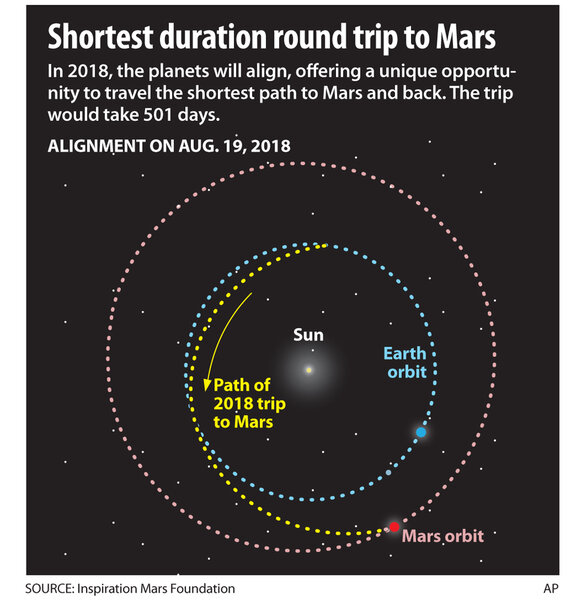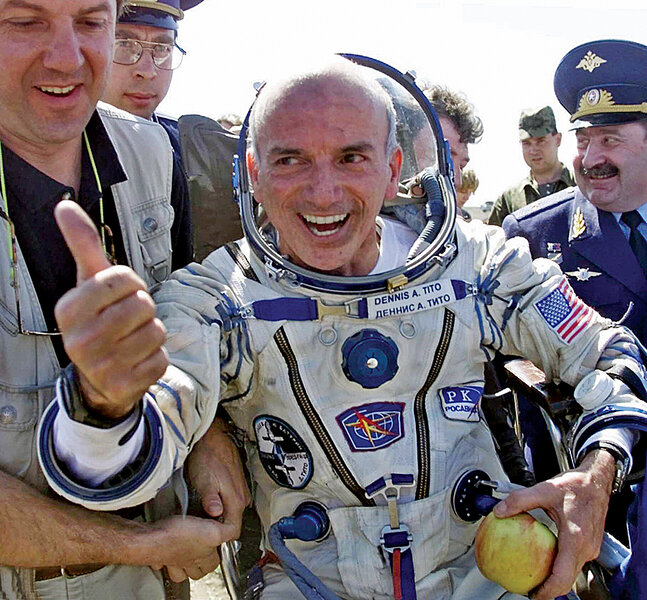What would 501-day mission to Mars feel like? 'Survivor' in space.
Loading...
For the Inspiration Mars project, it's the Red Planet or bust in 2018.
The plan is daring, and the challenges enormous. Multimillionaire Dennis Tito wants to send a manned spacecraft on a Mars flyby, and to do it, he will need to find money and the right hardware. But perhaps most intriguingly, he will need to find two people willing to hurtle through space together for 501 days in a capsule roughly the size of an ice-cream truck.
The question of how to keep astronauts healthy and relatively happy once they leave Earth is one that has commanded the attention of the US space program for 50 years. Now, the Inspiration Mars project is adding some urgency to the issue of how to keep astronauts healthy and happy for a year or more beyond the comparative safety of low-Earth orbit.
If humankind is to become a spacefaring species, as Mr. Tito clearly wishes, it is an issue that must be addressed. Space travelers will have to cope with an environment that affects them on scales from the molecular to the physiological and psychological.
For now, space enthusiasts trying to simulate long-term space travel are cramming themselves into confined habitats for months on end to learn how to prevent a potential space mission from devolving into a zero-gravity version of "Survivor." Scientists are performing experiments in terrestrial labs, and the National Aeronautics and Space Administration (NASA) is using the International Space Station to learn about how life in space affects humans – from microgravity to the lack of a conventional day-night cycle.
The Inspiration Mars project – if it truly gets off the ground – will certainly not be for the faint of heart, especially for the crew.
"Once they've left planet Earth, they ain't getting off that bus," Jayne Poynter, president and cofounder of a company working on life-support systems for Inspiration Mars, wryly noted at the project unveiling last month.
Incredible advances are taking place in this field in space and on Earth, "all with the aim of decreasing risks and allowing humans to spend longer and longer periods of time in space," says Jeffrey Sutton, a neuroscientist at Baylor University who heads the National Space Biomedical Research Institute in Houston.
The challenge, he says, is that "You have very healthy individuals that are going into a very dangerous environment and also an environment where day-to-day living is different."
That environment includes increased exposure to cosmic radiation and communications that can take the best part of an hour to complete. But the Inspiration Mars project, in particular, has highlighted the prospect of spending long periods of time in cramped quarters. Initial plans call for a spacecraft and two crew members – a male and female joined in a form of solitary confinement, if not matrimony – living in a 33-cubic-meter capsule. Even a larger volume for living and storage wouldn't erase the issues.
To understand how astronauts might cope in such environments, researchers and those who train astronauts pay close attention not just to the experiences of past and current astronauts, but also to Earth-bound simulations – a kind of near-Mars experience.
For instance, grumpiness can come easily with prolonged isolation, even when your "spaceship" or "habitat" sprawls across three acres, notes Ms. Poynter, chairwoman and president of Paragon Space Development Corporation, based in Tucson, Ariz.
She was one of eight people who spent two years and 20 minutes inside Biosphere 2, a vast structure on the backside of the Santa Catalina Mountains outside Tucson. The facility represented an experiment in designing and using a self-contained environment with a range of artificial ecosystems hospitable to plants, animals, and the crew.
Conceptually, it was the kind of large habitat one could envision as the nucleus of a colony on Mars. In practice, it often seemed a vehicle for turning molehills into mountains.
"There were mood swings; there was depression," especially moving into the third quarter of the mission, Poynter recalls. "We broke into warring factions, which is often common. In fact, for about 18 months of the mission, some of the crew members barely spoke to other crew members – only enough to actually operate the Biosphere. It could have been dangerous, and it certainly affected the creativity with which we could address the challenges that we had."
Such experiences underscore the importance of screening and training a crew, as well as the people who will staff "mission control," specialists say.
Indeed, the move toward long-duration, deep-space missions is changing the traits recruiters will be looking for in astronauts, suggests Stacy Cusack, who leads the chief training officers at NASA's Johnson Space Center in Houston.
A different kind of astronaut
This has already become apparent in the transition from two-week space-shuttle missions to six-month stays on the space station. In short, astronauts needed to be more MacGyver-like. The shift to interplanetary spaceflight will put an even higher premium on crew initiative and resourcefulness – and on mission control's skills at sensing when a crew member might need additional support from the ground.
Ms. Cusack is that rare individual who already has been to Mars twice, in a manner of speaking. She spent two weeks as a crew member at one of the Mars Society's analogue Mars habitats in the Utah desert. Seven years later, she spent five weeks as a crew member at the society's analogue habitat on Devon Island in the Canadian Arctic.
The simulations included communications delays similar to those a crew on Mars would experience – up to 40 minutes between phoning home and learning whether anybody was home to take the call.
"We quickly learned that with the comm[unication] delays and the distance you're dealing with the crew has to be incredibly autonomous. They are completely relying on each other to get everything done. They can't wait for help from mission control all the time," Cusack says.
That may be a blessing for mission control, as well. During both simulations, she says, "it was very interesting to me to see how quickly you get into an us-versus-them mentality."
She cites the "case of the clogged toilet system" during her stint at the habitat in Utah. Effluent flowed into the habitat.
"That was a really low point," she says. The crew needed plumbing diagrams and troubleshooting tips from the mission-support team. From the crew's perspective, the support team was too slow to respond or the information was incomplete.
"Crew frustration built very, very quickly to a point where we started feeling like we weren't even going to keep them in the loop anymore," she says. "We'd just have to do it on our own and let them figure it out later."
This was the sort of "freebie malfunction" – glitches not accounted for during training – that turns simulated expeditions into object lessons for real-deal mission planning.
The habitat experiences also showed the crucial role crew selection plays in a mission's success. It's not enough to build a team of individuals who are smart and capable, Cusack says. "The way you put that team together is also a huge factor."
So is the selection of a team leader. Of the two Mars Society expeditions in which she took part, the more successful one was led by someone who was able to keep the crew working well as a unit without being a dictator and with a keen eye to balancing workload, she says.
In some respects, one could find many of these points in a decent book on how to be an effective manager, Cusack acknowledges.
"Everyone has those intentions in mind," she says. "But in practice, especially when things get stressful, everyone's base personalities come out. When you're living with the same people day in and day out with no break from them, ever, all those little personality quirks become enhanced."
In some ways, it may be easier to confront the stress of space travel than the stress of Earth-based simulations, suggests Taber MacCallum, the cofounder and chief technology officer for Paragon Space Technology Development Corp. He also was a member of the Biosphere 2 crew and is now Poynter's husband.
At Biosphere 2, Mr. MacCallum recalls, he'd look at the air lock to the outside world every day and remind himself: I'm not going out that door. Astronauts have no choice but to stay. During conversations MacCallum says he had later with some Russian cosmonauts who have spent long periods in space, they agreed that a daily decision to stay or go would be an extra level of stress. Currently, the record for the longest human spaceflight is held by Russian Valeri Polyakov, who spent 437 days on the Mir space station in 1994-95.
Space station's role
The Earth analogues have their place in exploring the psychological dimensions of interplanetary space travel. NASA also participates in studies from a second remote training center on Devon Island. But NASA's primary tool for studying how a long-term space mission might affect astronauts is the space station.
To that end, NASA and Russia's space agency, Roscosmos, have tapped Scott Kelly and Mikhail Kornienko to team up for the first year-long stay on the International Space Station. They will test hardware and procedures for interplanetary missions and take part in biomedical tests as the space agencies look for ways to keep crews healthy. The duo is slated for launch sometime in the spring of 2015.
The space station is a unique laboratory for understanding how the body responds to microgravity. That field of study has come a long way since the early days of human spaceflight, when flight surgeons were worried that astronauts wouldn't be able to swallow in space or that they wouldn't be able to digest food.
The human body evolved in Earth's gravitational embrace, so spending long periods in microgravity "tends to be a pretty disruptive kind of change," says Julie Robinson, NASA's space-station program scientist.
But, she adds, "it's not nearly as disruptive as people thought before humans went into space. Our bodies turn out to be much more resilient than we thought."
One facet that has received attention recently is the effect a lack of the right kind of light and the lack of a day-night cycle can have on sleep patterns and crew effectiveness. Earlier this year, researchers reported the results of a study of sleep patterns among a six-member crew that spent 520 days inside a simulated capsule at the Russian Academy of Science's Institute of Biomedical Problems in Moscow.
As time went on, normal sleep patterns were disrupted, but the severity differed among the crew and overall. Armed with a detailed look at the disrupted patterns, the researchers noted that mission planners could schedule activities in ways that reduced the risks the altered patterns could pose to the crew's effectiveness.
Researchers have developed counter-measures for long-observed conditions such as space-motion sickness or the loss of bone and muscle mass in orbit.
But they don't have enough experience with missions of nine to 12 months' duration to know what course those conditions might take over longer periods of time, Dr. Robinson says.
And spaceflight can still spring unpleasant surprises. Over the past couple of years, she says, some crew members have experienced a buildup of fluids in the brain and spinal cord that impairs their vision, a condition, she says, that could become permanent on the ground.
No one had seen this condition before, and it now represents the most serious health risk astronauts in low-Earth orbit face, says the National Space Biomedical Research Institute's Dr. Sutton. He adds that it has affected about 25 percent of the male astronauts who have served on the space station.
Cosmic rays and solar wind
For travel beyond low-Earth orbit and the protection of Earth's magnetic field, radiation remains the biggest health concern, Sutton says. Galactic cosmic rays – charged particles and atomic nuclei accelerated to high energies – come from all directions. The sun also sheds particles as solar wind, and at higher energies, as solar storms.
So far, the only ways to reduce a crew's exposure involve making the trip to Mars as quickly as possible and putting as much shielding between the crew and the source as practical.
Jonathan Clark, an associate professor of neurology at Baylor University and a former NASA flight surgeon, estimates that Tito's one-off Mars mission would expose the couple to an elevated risk of cancer mortality of about 3 percent above NASA's maximum allowable career exposure for astronauts.
It's a risk longtime Mars exploration advocate Robert Zubrin, founder and president of the Mars Society, compares with the risk astronauts faced during the shuttle program.
NASA initially anticipated that the risk of losing a shuttle and its crew was about 1 in 100,000. Over the course of 100 missions, NASA lost two shuttles and 14 astronauts. That suggests, he says, that the increased cancer risk to an Inspiration Mars crew would be roughly comparable to the risk astronauts took when they were strapped into a shuttle.
If Inspiration Mars succeeds, its biggest contribution to interplanetary travel may well be slaying a cosmic equivalent of the sea dragons lurking over the horizon for sailors in the Middle Ages, he says.
Fear of the dragon is the showstopper for NASA, he says, not the radiation itself. If Inspiration Mars succeeds, "it can destroy the fear. This can show it can be done."










